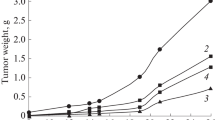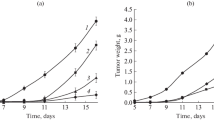Abstract—The antitumor efficacy of the combined use of the binuclear dinitrosyl iron complex with glutathione as an exogenous donor of cytotoxic nitrosonium cations and sodium diethyldithiocarbamate has been explored in a model study of mice with Lewis lung carcinoma. The tumor-inhibiting effects of the dinitrosyl iron complex (2 μM/kg, IV), sodium diethyldithiocarbamate (250 μM/kg, IP), and their combination were 48, 76, and 57%, respectively. These results suggest that the effect is determined by the ability of sodium diethyldithiocarbamate to decompose endogenous dinitrosyl iron complexes in tumors, so that nitrosonium cations are released from these complexes, thereby enhancing the antitumor effect of the concomitant medication to some extent.

Similar content being viewed by others
REFERENCES
A. F. Vanin, L. A. Ostrovskaya, D. B. Korman, et al., Biophysics (Moscow) 59 (3), 415 (2014).
A. F. Vanin, L. A. Ostrovskaya, D. B. Korman, et al., Biophysics (Moscow) 60 (1), 121 (2015).
A. F. Vanin, L. A. Ostrovskaya, D. B. Korman, et al., Biophysics (Moscow) 60 (6), 963 (2015).
A. F. Vanin, L. A. Ostrovskaya, and D. B. Korman, Austin J. Reprod. Med. Infertil. 2, 1109 (2015)
A. F. Vanin, L. A. Ostrovskaya, D. B. Korman, et al., Biophysics (Moscow) 62 (3), 479 (2017).
A. F. Vanin, L. A. Ostrovskaya, D. B. Korman, et al., Biophysics (Moscow) 64 (6), 999 (2019).
A. F. Vanin, L. A. Ostrovskaya, D. B. Korman, et al., Biophysics (Moscow) 65 (1), 39 (2020)
A. F. Vanin, L. A. Ostrovskaya, D. B. Korman, et al., Biophysics (Moscow) 65 (5), 863 (2020).
A. F. Vanin, V. A. Tronov, and R. R. Borodulin, Cell Biochem. Biophys. 79 (1), 93 (2021)
A. F. Vanin, Dinitrosyl Iron Complexes as a “Working Form”of Nitric Oxide in Living Organisms (Cambridge Scholars Publ, Cambridge, UK, 2019).
A. F. Vanin, D. I. Telegina, V. D. Mikoyan, and S. V. Vasilieva, Cell Biochem. Biophys. (2021), in press.
R. R. Borodulin, L. N. Kubrina, V. O. Shvydkiy, et al., Nitric Oxide Biol. Chem. 35, 110 (2013).
E. M. Treshchalina, O. S. Zhukova, G. K. Gerasimova, et al., in Guidelines for Conducting Preclinical Trials of Medicinal Products, Vol. 1 (Grif i K, Moscow, 2012), pp 642–657.
H. Lewandowska, T. M. Stepkowski, S. Meszynska-Wielgosz, et al. J. Inorg. Biochem. 188, 29 (2018)
J. C. Drapier, C. Pellat, and Y. Henry, J. Biol. Chem. 266, 10162 (1991).
N. M. Emanuel, A. N. Saprin, V. A. Shabalkin, et al., Nature 222, 165 (1969).
T. Maruyama, N. Kataoka, S. Nagase, et al., Cancer Res. 31, 179 (1971)
N. R. Bastian, C. Y. Yim, J. B. Hibbs, et al., J. Biol. Chem. 269, 5127 (1994)
M. C. R. Symons and I. J. Rowland, Free Rad. Res. Comms. 21, 197 (1994)
J. R. Hickok, S. Sahni, H. Shen, et al., Free Rad. Biol. Med. 51, 1559 (2011)
H. C. Lok, Y. S. Rahmanto, C. L. Hawkins, et al., J. Biol. Chem. 287, 507 (2012)
H. C. Lok, S. Sahni, P. J. Jansson, et al., J. Biol. Chem. 291, 27042 (2016)
A. L. Kleschyov, S. Strand, S. Schmitt, et al., Free Rad. Biol. Med. 40, 1340 (2006).
Author information
Authors and Affiliations
Corresponding author
Ethics declarations
Conflict of interests. The authors declare that they have no conflict of interest.
Statement on the welfare of animals. All applicable international, national, and/or institutional guidelines for the care and use of animals were followed.
Additional information
Translated by V. Gulevich
Abbreviations: M- and B-DNICs, mono- and binuclear dinitrosyl iron complexes; IP, intraperitoneal; IV, intravenous; DETC, sodium diethyldithiocarbamate; B-DNIC-GSH, binuclear dinitrosyl iron complex with glutathione; GS-NO, S‑nitrosoglutathione.
Rights and permissions
About this article
Cite this article
Vanin, A.F., Ostrovskaya, L.A., Korman, D.B. et al. The Nitrosonium Cation as a Component of Dinitrosyl Iron Complexes Mediates their Antitumor Effect. BIOPHYSICS 66, 1037–1040 (2021). https://doi.org/10.1134/S0006350921060191
Received:
Revised:
Accepted:
Published:
Issue Date:
DOI: https://doi.org/10.1134/S0006350921060191




